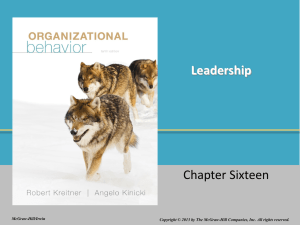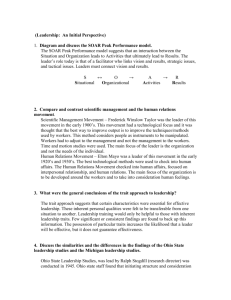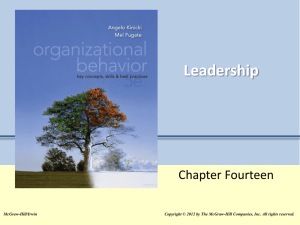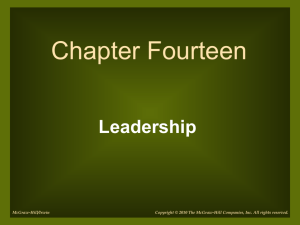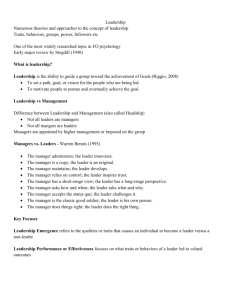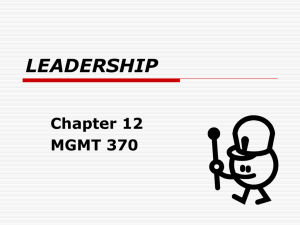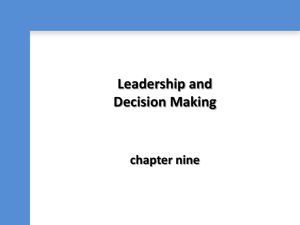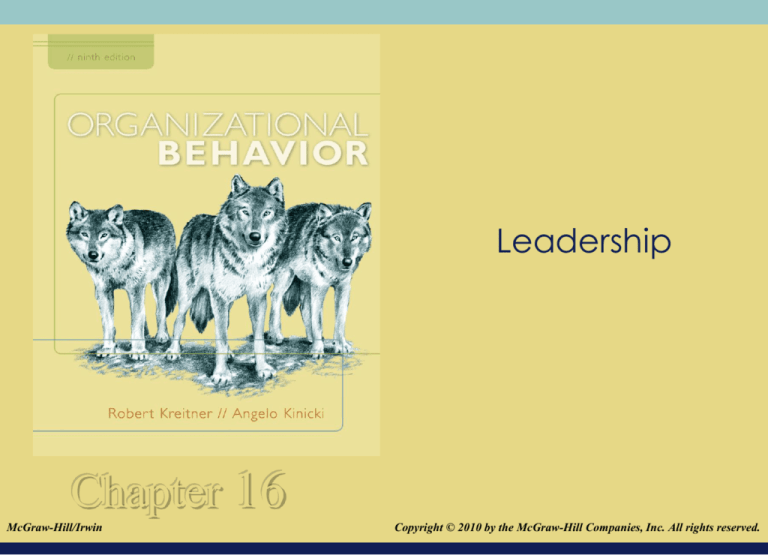
Leadership
Chapter 16
McGraw-Hill/Irwin
Copyright © 2010 by the McGraw-Hill Companies, Inc. All rights reserved.
© 2008The McGraw-Hill Companies, Inc. All rights reserved.
Ch. 16 Learning Objectives
1. Define the term leadership and explain the
difference between leading and managing.
2. Review trait theory research and the takeaways from
this theoretical perspective.
3. Explain behavioral styles theory and its takeaways.
4. Explain, according to Fiedler’s contingency model,
how leadership style interacts with situational
control, and discuss the takeaways from this model.
5. Discuss House’s revised path-goal theory and its
practical takeaways.
16-2
Ch. 16 Learning Objectives
6. Describe the difference between laissez-faire,
transactional, and transformational leadership.
7. Discuss how transformational leadership transforms
followers and work groups.
8. Explain the leader-member exchange model of
leadership.
9. Review the concept of shared leadership and the
principles of servant-leadership.
10. Describe the follower’s role in the leadership
process.
16-3
A Leader Is Someone Who…
…influences a group of individuals to achieve a
common goal. Key aspects of leadership include…
• Creating and communicating a vision
• Influencing others through use of power
• Motivating task behavior in pursuit of shared objectives
• Establishing and maintaining group culture
• Empowering others
• Clarifying roles and niche in marketplace
• Making tough decisions with limited information
16-4
Approaches to Studying Leadership
Trait approaches
Behavioral
approaches
Contingency
approaches
Transformational
Approaches
Emerging
Approaches
16-5
Leaders & Managers
16-6
Leaders and Managers
Leaders
•
•
•
•
Inspire & Motivate
Manage People
Are Decisive
Create a Vision
Managers
•
•
•
•
Are Accountable
Execute
Manage Resources
Plan, organize, direct,
control
Managers who are also leaders
16-7
Trait Approach to Leadership
“Great Man” approach
• Attempt to identify relatively stable,
enduring dispositional attributes
that leaders possess
Implicit Leadership Theory
• Beliefs about how leaders should
behave and should do for their
followers
Emotional Intelligence
• Ability to manage oneself and one’s
relationships in mature and
constructive ways.
16-8
Key Positive Leadership Traits
Intelligence
Self-confidence
Determination
Honesty/Integrity
Sociability
Extroversion
Conscientiousness
Problem solving skills
16-9
Ineffective Leadership Traits
Incompetent
Rigid
Intemperate
Callous
Corrupt
Insular
Evil
16-10
Practical Implication: Trait Theories
Personal Implications
• Predispositions: Personality tests and other trait
assessments will reveal predispositions
• Development Plans: However, targeted plans aimed at
adapting and learning new behaviors can be effective
ways to develop leadership talent
Organizational Implications:
• Use valid measures of job-related traits to select
employees
• Create management development programs
16-11
Behavioral Styles Theory
Ohio State Studies
Low Consideration
Behavior
High Consideration
Behavior
Low Initiating
Structure Behavior
High Initiating
Structure Behavior
16-12
Four Leadership Styles
Showing Consideration
High
Low
Seeks input from
others before taking
action; gets consensus
Emphasizes reaching the
goal while welcoming
suggestions and
encouraging consensus
Passive,
noncommittal, low
impact on followers
Takes charge,
structures employees
tasks
Low
High
Initiating Structure
16-13
Drucker’s Leadership Effectiveness Tips
1. Determine what needs to be done.
2. Determine the right thing to do for the welfare of the
entire enterprise
3. Develop action plans
4. Take responsibility for decisions.
5. Take responsibility for communicating action plans
6. Focus on opportunities rather than problems.
7. Run productive meetings
8. Think and say “we” rather than “I”.
9. Listen first, speak last.
16-14
Test Your Knowledge
Natalia tends to ensure her team is on board with
any decision she makes. The productivity of her
team is below the level of other teams in her business
unit. Based on the Ohio State leadership studies
Natalia is probably:
a.
b.
c.
d.
High on consideration, high on initiating structure
High on consideration, low on initiating structure
Low on consideration, low on initiating structure
Low on consideration, high on initiating structure
16-15
Behavioral Styles: Key Takeaways
Challenged assumption that leaders are born,
not made
Defined “leadership” in actual behaviors
There is no one best style of leadership –
depends on the situation
An “effective” leader behavior can be
misused and have negative consequences for
employees
16-16
Contingency Approaches to Leadership
Effective traits and behaviors depend on the situation
Fiedler’s Contingency Theory
• Premise: There must be a match between the leader’s
style and the demands of the situation for the leader to
be effective.
• Assumption: Leadership style does not change. If a
mismatch occurs between style and the situation,
change the situation.
16-17
Fiedler’s Contingency Theory
Situation depends
on three variables:
1: Leader-Member
Relations
2: Task Structure
3: Position Power
16-18
Your Experience
Have you been in a situation where, as a
leader, one of these situational factors were
not in your favor? A=Yes, B=No
If Yes, was it more practical to _________ in
response to the situation
a. change the situation
b. change your behaviors
Do you agree that leaders have one dominant
style? A=Yes, B=No
16-19
Representation of Fiedler’s Contingency
Model
Situational Control
High Control Situations
Moderate Control Situations
Low
Control
Situations
Leader-member
relations
Good
Good
Good
Good
Poor
Poor
Poor
Poor
Task Structure
High
High
Low
Low
High
High
Low
Low
Position Power
Strong
Weak
Strong
Weak
Strong
Weak
Strong
Weak
Situation
I
II
III
IV
V
VI
VII
VIII
Optimal
Leadership
Style
Task-motivated
Leadership
RelationshipMotivated
Leadership
TaskMotivated
Leadership
16-20
Fiedler’s Model: Key Takeaways
Leadership effectiveness is comprised of:
• Traits,
• Behaviors, and
• Situational factors
Organization implications
• Give some consideration to the situational context when
placing people in leadership roles
• Poor leadership in one context may not mean poor
leadership in a different situation
• Organization’s should provide training/mentoring to
increase leaders’ adaptability
16-21
House’s Revised Path-Goal Theory
Employee
Characteristics
Locus of control
Leader Behaviors
Task ability
Need for achievement
Path-goal clarifying
Experience
Achievement oriented
Need for clarity
Leadership
Effectiveness
Work facilitation
Employee motivation
Supportive
Employee satisfaction
Interaction facilitation
Employee performance
Group oriented-
Leader acceptance
decision making
Representation and
networking
Value based
Environmental Factors
Work-unit performance
Task structure
Work group dynamics
16-22
Path Goal: Key Takeaways
Effective leaders possess and use more than
one style of leadership
•Managers should try new behaviors based on
situational demands
Leaders should clarify paths to goal
accomplishment and remove obstacles
Employee and environmental characteristics
impact the type of leadership style that will be
most effective
16-23
Applying Situational Theories
Identify important outcomes
• What are you trying to achieve?
Identify relevant leadership
types/behaviors.
• What types of behaviors may be appropriate for this
situation? Select one or two best ones.
Identify situational conditions.
• What are the practical considerations that affect your
leadership approach?
16-24
Applying Situational Theories
Match leadership to the conditions
at hand.
• Do your best to determine the leadership
behavior to use given the situation.
Determine how to make the match.
• Change the leader or change the leader’s style?
16-25
Transactional Vs. Transformational
Leadership
Transactional
Leadership focuses
on clarifying
employees’ roles and
providing rewards
contingent on
performance
Appeals to what
followers want
(rewards)
Transformational
transforms employees
to pursue
organizational goals
over self-interest
Appeals to followers’
values, beliefs, selfconcept
16-26
Transformational Model of Leadership
Ind. & Org.
characteristics
Leader behavior
Traits
Inspirational
motivation
Life
Experiences
Organizational
Culture
Idealized influence
Individualized
consideration
Intellectual
stimulation
Effects on followers
and work groups
Outcomes
Increased intrinsic
motivation,
achievement
orientation, and goal
pursuit
Personal
commitment to
leader and vision
Increased
identification with
the leader
Self-sacrificial
behavior
Increased
cohesion among
workgroup members
Organizational
commitment
16-27
The Leader-Member Exchange
(LMX Model)
Assumption: Leaders do not treat all
employees in the same way – it is based
on their one-on-one relationship.
• In-group exchange: a partnership
characterized by mutual trust, respect
and liking
• Out-group exchange: a partnership
characterized by a
lack of mutual trust, respect and liking
16-28
Shared Leadership
… a dynamic interactive
influence process among
individuals in groups for
which the objective is to lead
one another to the
achievement of group or
organizational goals or both.
16-29
Shared Leadership
16-30
Servant Leadership
Servant Leadership
focuses on increased
service to others rather
than to oneself
16-31
Servant Leadership Characteristics
Servant-Leadership
Characteristics
Description
1)
Listening
Focus on listening to identify and
clarify the needs and desires of the
group
2)
Empathy
3)
Healing
Try to empathize with others’ feelings
and emotions
Strive to make themselves and others
whole in the face of failure or suffering
4)
Awareness
5)
Persuasion
Very self-aware of their strengths and
limitations
Rely on persuasion when making
decisions and trying to influence others
16-32
Servant Leadership Characteristics
Servant-Leadership
Characteristics
Description
6)
Conceptualization
Seek the appropriate balance between
a short-term, day-to-day focus, and a
long-term, conceptual orientation
7)
Foresight
Have ability to foresee future outcomes
associated with a current course of
action or situation
8)
Stewardship
Assume they are stewards of the
people and resources they manage
16-33
Servant Leadership Characteristics
Servant-Leadership
Characteristics
9)
10)
Commitment to the growth
of people
Building community
Description
Committed to people beyond their
immediate work role
Strive to create a sense of community
both within and outside the work
organization
16-34
Followers
Significance
• Emphasize the meaningfulness of the work one does
Community
• Provide a sense of unity and encourage people to
treat others with respect and dignity
Excitement
• Promote feelings of engagement and energy
16-35
Test Your Knowledge
Which of the following is true?
a. A leader is responsible for the quality of the
relationships with his/her subordinates.
b. Followers who protect their leaders from bad news are
appreciated.
c. Followers should focus on doing a good job and not try
to learn about their manager’s style, strengths or
weaknesses.
d. Followers should build on mutual strengths and adjust
to accommodate the leader’s style, goals, expectations
and weaknesses.
16-36


